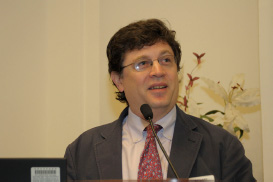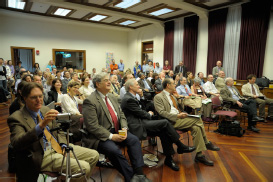Symposium Honors NIAM's Paul Plotz

Photo: Rhoda Baer
Paul Plotz “was my Sarastro when I came to NIH,” said Richard Siegel, chief of NIAMS’s Autoimmunity Branch, comparing his mentor to the wise and enlightened high priest of the Temple of Isis in Mozart’s opera The Magic Flute. Plotz was “an oasis of calm in an ocean of chaos … guiding me through the tenure track.”
Siegel joined with dozens of other scientists to celebrate the career of recently retired Paul Plotz at the symposium “A Vocation in Medicine: Autoimmunity, Autophagy, Muscle Disease and Human Rights,” held on May 19. The symposium honored the rheumatologist’s achievements in advancing our understanding of autoantibodies, autoimmune disease, and inflammatory muscle diseases, and it illustrated the profound impact he has had on other luminaries in these fields.
Colleagues, collaborators, patients, and friends from across the span of Plotz’s career took the podium, describing how his work had changed their lives, their work, or, in many cases, both. Siegel asked, tongue-in-cheek, what some younger trainees, based on their laughter, must have imagined to be the case: “So, did our Sarastro arrive, fully formed, in Brooklyn?”

Photo: Bill Branson
Paul Plotz (above, center) mentored and inspired other scientists including NIAMS Autoimmunity Branch Chief Richard Siegal (below).

Photo: Bill Branson
The answer: Not quite! Plotz, the son of a cardiologist, is a fourth-generation physician, but he graduated from Harvard with a degree in physics. Ezekiel Emanuel, chief of the department of bioethics at the Clinical Center, told the audience that Plotz once confessed that although he loved physics, he felt he lacked an intuition for it, a feel for the physical world. And so, with only one chemistry and no biology courses under his belt, Plotz applied to Harvard Medical School. It was there that he discovered his true vocation as a physician and scientist, there that he was influenced by working in the laboratory of Bernard Davis, a pioneer in molecular biology and bacterial genetics who wrote the standard textbook of the time on microbiology.
Robert Kimberly, a rheumatologist who trained in Plotz’s laboratory in the 1970s, discussed the genesis of the first paper he published with Plotz, a seminal one in the New England Journal of Medicine that described the toxic effects of aspirin on renal function (N Engl J Med 296(8):418–424, 1977). He recounted that it was the product of long hours spent holed up in rooms on the ninth floor of Building 10, “unswirling” their data on prostaglandins and setting the stage for the development of a new class of therapeutics, cyclooxygenase-2 (COX-2) inhibitors.
Plotz had life-long commitment to human rights. Walter Reich, the physician who co-chairs the Committee of Concerned Scientists with Plotz, said, “It is a part of Paul’s life that explains so much else about what he has done, including his vocation in medicine, and how could it not be otherwise.” Reich shared examples of this work, including Plotz’s role in helping Soviet refusenik scientists emigrate to the United States in the mid-1980s and his work in the 1960s with the U.S. Public Health Service investigating Southern hospitals suspected of segregating patients.
Cornelius Boerkoel, director of the NIH Undiagnosed Diseases Program’s Translational Laboratory, was a medical student on an immunology rotation at a critical time in Plotz’s lab, when it began research on Pompe disease.
He told the gathering, “In many ways, Paul rescued my career in medicine.” Boerkoel, a then-new physician who had had trained previously as a theologian, had become disillusioned with medicine and the inability of basic research to help patients. “I had patients in front of me who needed a solution,” said Boerkoel. “I had been trained to use basic science tools, but the way the system worked was, you collected a cohort, … you built a mouse model, and then, maybe in five decades, you could make a difference to that person you saw. So, I had a dilemma—a personal crisis.”
But, Boerkoel said, he met a woman in the clinic one day with a then-lethal muscle disorder called Pompe syndrome, thought only to afflict infants. Plotz encouraged him to look for the gene mutations, and Boerkoel found them. When they shared the findings with the patient—findings that could not help her—she was joyful and grateful because they might help her children or their children. “That moment solidified for me what I would do with what I had trained to do—apply basic research tools, one by one,” Boerkoel said. Plotz taught him that that “for these patients, research is care. There is no distinction.”
Plotz’s colleague, Nina Raben, an NIAMS staff scientist who came to NIH during the exodus of Soviet scientists that Reich had mentioned, expressed what many attendees felt: “We have not yet cured Pompe disease. From my perspective, Paul’s retirement is really premature.” And so his collaborators and colleagues wished Plotz good luck but not goodbye. He will continue his work as a scientist emeritus in the NIAMS intramural program.
Paul H. Plotz, M.D.: From Physics to Physician
NIH scientist emeritus Paul Plotz, who was honored at a recent symposium, received his bachelor’s degree in physics from Harvard College (Cambridge, Mass.). In 1963, he earned his M.D. degree from Harvard Medical School (Boston) where he began his research career with Professor Bernard Davis, who made major contributions in microbial physiology and metabolism. Plotz did a residency in internal medicine at the Beth Israel Hospital in Boston and a fellowship in rheumatology at NIH’s Clinical Center.

Photo: Bill Branson
Dozens of scientists gathered to celebrate the career of NIAMS scientist emeritus Paul Plotz at a symposium held at NIH this spring.
Plotz worked at NIH for 40 years, with the exception of two years when he did basic research in immunology in Avrion Mitchison's lab at the National Institute for Medical Research at Mill Hill (London). His early work was largely in immunology; he studied the biology of immune complexes in patients, in animals, and in vitro with stable model immune complexes using affinity labeling polymeric antigens that he invented.
With his fellows Bill Seaman and Bob Kimberly, Plotz described the major hepatic and renal toxicities of aspirin and related prostaglandin synthetase–inhibiting drugs. With Bruce Scharschmidt, he developed an extracorporeal affinity perfusion system to remove bilirubin and other toxins from the circulatory system.
After returning from a sabbatical year at the Kennedy Institute of Rheumatology in London in 1981, Plotz concentrated on the study of inflammatory muscle disease in order to understand the autoimmune phenomena associated with rheumatologic diseases. He and his colleagues, particularly Fred Miller, worked on clinical and basic aspects of myositis, a rare autoimmune disease that destroys muscles. In recent years he has been studying and trying to cure one of them—Pompe disease, a rare genetic disorder that results in profound muscle weakness and closely mimics myositis.
His longtime colleague Nina Raben leads studies on Pompe syndrome that are aimed at developing enzyme- and gene-replacement therapy.
Plotz has served as chief of NIAMS’s Arthritis and Rheumatism Branch, scientific director, and acting deputy director. He was also appointed as a senior advisor to Deputy Director for Intramural Research Michael Gottesman.
Plotz has received many prizes, has lectured widely, and is a Master of the American College of Physicians. As scientist emeritus, he plans to continue doing clinical and basic research on myositis and other inflammatory muscle diseases.
This page was last updated on Monday, May 2, 2022
